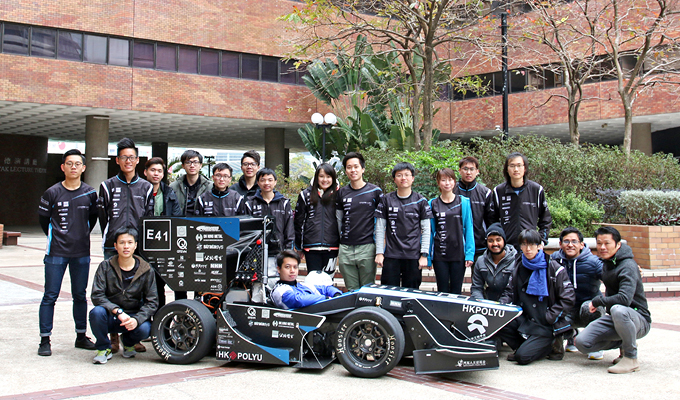HKPolyU Racing, the first and only formula racing team formed by local university students represented Hong Kong to compete in last year’s Formula Student Electric China (FSEC) with their self-designed racing car HKF-01E. Members of the team shared their journey in chasing their racing dream as well as the design for their new racing car HKF-02E in preparation for the 2018 FSEC.
1. How did you come up with the idea of building a racing car?
In 2015, nine of us from the Department of Mechanical Engineering had an idea to build a racing car for joining a formula competition as our Final Year Project. While most may think that this is merely a dream, we received full support from the University and received about HK$600,000 funding from various faculties and departments.
Our university education inspired us to apply our professional skills and knowledge in devising innovative solutions to problems. Therefore, we decided to expand the racing team and leverage on the skillsets of members from various disciplines. Engineering student members focused on the mechanical and technical parts of the racing car while business student members were in charge of marketing and soliciting sponsorships. Teammates from the Institute of Textiles and Clothing designed our uniforms while those from the School of Design took charge of the branding and visual designs, including our logo and the appearance of HKF-01E.
2. Could you introduce the special features of HKF-01E?
As a newcomer team designing and manufacturing a race car for the first time, we were quite aggressive in the design of HKF-01E. It involved dual-motor drivetrain design and 3D printing technology to manufacture the internal structure of the car and the moulds for producing carbon fibre components. These were made possible with the support and guidance from PolyU’s academic and technical staff as well as manufacturing support from Industrial Centre, University Research Facility in 3D Printing and various engineering workshops.
3. Could you share any unforgettable experience at the competition?
We sent our racing car to Xiangyang, Hubei, about a month prior to the competition. Unfortunately, upon arrival, our car failed to function due to problems with two of the battery packs. We spent days and nights in the garage, dismantling and reinstalling the battery packs, with only several hours of sleep in between. Other competing teams from mainland universities lent us tools to fix our car and we were very touched by their generosity.
The competition was comprised of dynamic and static events. Dynamic events took place on the racing track while judges evaluated the cars in the static events. All competing cars were required to pass scrutineering and safety checks in order to participate in the dynamic events.
In the dynamic events, as we were not familiar with the specific requirements of certain automotive components, we spent a long time to pass all the scrutineering and safety checks and missed most of dynamic events. We finally made it to the racing track for the power efficiency event. Unfortunately, after a few laps, our car broke down and failed to restart, resulting in disqualification from the event.
4. Are you satisfied with the competition results and what are your plans to prepare for the 2018 FSEC?
We were a bit disappointed to be ranked 28th out of the 43 competing teams. However, it was encouraging that we were placed 2nd among all newcomer teams. As an overseas team, we faced the challenge to get ready our car a month before the competition, allowing sufficient time to ship it to the competition venue. Not only would the logistic process cause unforeseeable damage to the car, the shipping cost was very high, taking up 25% of our HK$600,000 funding.
Preparation for the 2018 FSEC is underway and we are working on the design of our second generation racing car HKF-02E. We plan to use batteries of higher energy density, reducing battery weight and the number of batteries from 220 to 96. We will also develop a new battery management system to detect the temperature and voltage of each battery. We also plan to replace steel with carbon fibre composite to manufacture the battery box.
Looking forward, we would like to take part in formula student electric car competitions in other countries like Japan and Germany as well as other kinds of competitions such as autonomous vehicle competitions.
